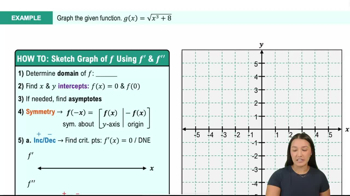Table of contents
- 0. Functions7h 52m
- Introduction to Functions16m
- Piecewise Functions10m
- Properties of Functions9m
- Common Functions1h 8m
- Transformations5m
- Combining Functions27m
- Exponent rules32m
- Exponential Functions28m
- Logarithmic Functions24m
- Properties of Logarithms34m
- Exponential & Logarithmic Equations35m
- Introduction to Trigonometric Functions38m
- Graphs of Trigonometric Functions44m
- Trigonometric Identities47m
- Inverse Trigonometric Functions48m
- 1. Limits and Continuity2h 2m
- 2. Intro to Derivatives1h 33m
- 3. Techniques of Differentiation3h 18m
- 4. Applications of Derivatives2h 38m
- 5. Graphical Applications of Derivatives6h 2m
- 6. Derivatives of Inverse, Exponential, & Logarithmic Functions2h 37m
- 7. Antiderivatives & Indefinite Integrals1h 26m
- 8. Definite Integrals3h 25m
5. Graphical Applications of Derivatives
Curve Sketching
Problem 33
Textbook Question
Graphing functions Use the guidelines of this section to make a complete graph of f.
f(x) = (x2 + 12)/(2x + 1)
 Verified step by step guidance
Verified step by step guidance1
Identify the domain of the function f(x) = \frac{x^2 + 12}{2x + 1}. The function is undefined where the denominator is zero, so solve 2x + 1 = 0 to find x = -\frac{1}{2}. Thus, the domain is all real numbers except x = -\frac{1}{2}.
Determine the vertical asymptote by setting the denominator equal to zero. Since 2x + 1 = 0 at x = -\frac{1}{2}, there is a vertical asymptote at x = -\frac{1}{2}.
Find the horizontal asymptote by comparing the degrees of the numerator and the denominator. Since both the numerator and the denominator are of degree 2 and 1 respectively, divide the leading coefficients: \frac{1}{2}. Therefore, the horizontal asymptote is y = \frac{1}{2}.
Calculate the x-intercepts by setting the numerator equal to zero: x^2 + 12 = 0. Since this equation has no real solutions, there are no x-intercepts.
Evaluate the behavior of the function as x approaches the vertical asymptote and as x approaches infinity to understand the end behavior. This will help in sketching the graph accurately, showing how the function behaves near the asymptotes and at extreme values of x.
Recommended similar problem, with video answer:
 Verified Solution
Verified SolutionThis video solution was recommended by our tutors as helpful for the problem above
Video duration:
14mPlay a video:
Was this helpful?

 11:41m
11:41mWatch next
Master Summary of Curve Sketching with a bite sized video explanation from Callie
Start learning




